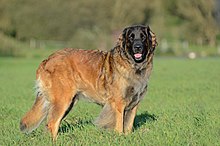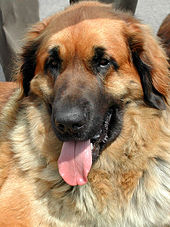Leonberger
The Leonberger is a giant dog breed. The breed's name derives from the city of Leonberg in Baden-Württemberg, Germany. According to legend, the Leonberger was ostensibly bred as a 'symbolic dog' that would mimic the lion in the town crest. It is in the Working Group for dog shows such asCrufts, but not at the World Dog Show.
Appearance
This Mountain dog comes with a generous double coat, the Leonberger is a large, muscular, and elegant dog with balanced body type, medium temperament, and dramatic presence. The head is held proudly, adorned with a striking black mask, and projects the breed's distinct expression of intelligence, pride, and kindliness. Remaining true to their early roots as a capable family andWorking dog and search and rescue dog (particularly water), the surprisingly agile Leonberger is sound and coordinated, with both strength in bearing and elegance in movement. A dimorphicbreed, the Leonberger possesses either a strongly masculine or elegantly feminine form, making gender immediately discernible.[1] When properly trained and socialized, the Leonberger is vigilant, loyal, and confident in all situations. Robust, adaptable, obedient, intelligent, playful, and kindly, the Leonberger is an appropriate family companion for modern living conditions.[2]
Size, Proportion, and Substance
Height at withers:
- Male: 28 to 31.5 inches (71 to 80 cm)-average 29.5 inches (75 cm) [2][3]
- Female: 25.5 to 29.5 inches (65 to 75 cm)-average 27.5 inches (70 cm) [2][3]
Weight:
- Males: 120–170 pounds (54–77 kg)-average 140–150 pounds (64–68 kg) .
- Females: 100–135 pounds (45–61 kg)-average 115 pounds (52 kg).
For a mature Leonberger, the height at the withers is ideally the median of the breed's range— 28 to 31.5 inches (71 to 80 cm) for males and 25.5 to 29.5 inches (65 to 75 cm) for females. The weight of its trim, well-muscled body is in direct proportion to its size. Elegantly assuming a rectangular build, the Leonberger is a well-balanced dog in form and function; the proportion of its height to its length is about nine to ten. Necessary for efficient movement and providing for a harmonious silhouette, its front and rear angulation are moderate and balanced. Capable of demanding work, the Leonberger is a dog of ample substance. Its frame is effortlessly supported with well-muscled, medium to heavy bone in direct proportion to its size. A roomy chest is sufficiently broad and deep for the purpose of work. Seen in profile, the chest curves inward from the pro-sternum, tangently joins the elbow to its underline at fifty percent of the withers' height and then continues slightly upward toward the stifle.[2]
Head
Correct head and expression in harmony with overall size and coat, are hallmarks of the Leonberger and are always appropriately masculine or feminine. The head is well balanced in proportion to the size of the dog and is deeper than broad with the length of muzzle and the length of skull approximately equal. The head is painted with a striking black mask that extends above the eyes; the Leonberger's good-natured expression is elegant, intelligent and confident. Likewise, the nose and lips are black and effortlessly blend with his dark mask. With close fitting eyelids, the eyes are elegantly set into the skull upon a slight oblique; the eyes are medium sized, almond shaped, and colored a rich dark brown. Integral to the head's silhouette, the ears are fleshy, moderately sized, and pendant shaped, with sufficient substance to hang close to the skull and drop the tip of the ears level with the inside corners of the mouth. Vigilantly set slightly forward, when alerted, the Leonberger's ears rise from halfway between the eye and the top of his skull to level with the top of his skull. True to his refined nature, the upper lip fits tightly and seamlessly around the lips of a strong lower jaw, preventing drooling (unlike many other Mastiff-like dogs) under most circumstances. Though level bites and slight anomalies not affecting the robustness of the lower jaw are common, the ideal Leonberger capably possesses a strong scissor bite with full dentition.[2]
Topline
Well muscled in support of a proudly held head, the Leonberger's neck flows elegantly from the backskull into well laid back shoulders, blending smoothly into withers on the topline and flowing cleanly through the underline. The backline remains strong and level through the rump. Coupled with a pronounced pro-sternum and conducive to strenuous work, a well sprung, oval-shaped rib cage supports a moderately broad and roomy chest, achieving a depth sufficient to meet properly placed elbows. Back and loin are broad and strongly coupled with a slight tuck-up. The croup smoothly slopes into his tail which is set just below the level of the back. The tail is rather long and reaches the hock of a properly angulated rear assembly; the tail is also well furnished and blends harmoniously with rear feathering. Denoting their confidence when in repose, the Leonberger's tail hangs straight down. Though showy males may adopt a sickle tail in the ring and leonbergers' tails commonly manifest excitement or rise toward the level of the back in movement, the ideal tail carriage is always relaxed.[2]
Coat
Both a necessity for work and a defining attribute of the breed, the Leonberger has a generous, water resistant, double coat on his body that is complemented by the shorter, fine hair on his muzzle and limbs. The long, profuse, outer coat is durable, relatively straight, lies flat, and fits close, strengthening his silhouette. Mature, masculine Leonbergers exhibit a pronounced mane which proudly parades the entirety of his neck and chest, helping to define a lion-like outline. The Leonberger is harmoniously festooned with distinct, ample feathering on the back of his forelegs and breeches. Similarly, his tail is very well furnished from the tip to the base where it blends harmoniously with the breech's furnishings. Climate permitting, his undercoat is soft and dense. Apart from a neatening of the feet, the Leonberger is presented untrimmed.
Color
Accompanying his striking black mask, a variety of coat colors are acceptable, including all combinations of lion-yellow, red, red-brown, and sand. His coat may be highlighted with black tippings which add depth without ever dominating the overall color.[2] Nose leather, foot pads and lips should always be black. Faulty colours include brown with brown nose leather, black and tan, black, white or silver and eyes without any brown. A small patch of white on the chest or toes is permitted.[4]
Temperament
First and foremost a family dog, the Leonberger's temperament is one of its most important and distinguishing characteristics. Well socialized and trained, the Leonberger is self-assured, insensitive to noise, submissive to family members, friendly toward children, well composed with passersby, and self-disciplined when obliging its family or property with protection. Robust, loyal, intelligent, playful, and kindly, they can thus be taken anywhere without difficulty and adjust easily to a variety of circumstances, including the introduction of other dogs.[1]
Movement
With an efficient, balanced, ground-covering gait, the Leonberger is effortless, powerful, free, and elastic in movement.[5] Balanced, and controlled at the trot, he always maintains a level topline. Viewed from the front or from behind, forelegs and hind legs travel straight. Increasing reach and drive, his legs tend to converge toward the centerline of the body as his speed increases.
Care and maintenance
The Leonberger sheds fur very heavily. A good brushing every week is sufficient to keep it in fine shape, except when the undercoat is being shed; then daily combing or brushing is in order for the duration of the moult. Regular use of a drag comb (it looks like a small rake), especially in the undercoat, is highly effective. The Leonberger should never be shaved.[6] Its double coat insulates against both heat and cold, and shaving can affect the dog's natural body temperature regulation. Regrowth is also more likely to be curly and therefore more susceptible to matting. See Dog grooming. A Leonberger is a family dog, the desire to be with his pack is far more important than a large yard, he can adapt to modest living quarters if he is given time with his people, a daily walk and regular training time. Leonbergers are good with children, family pets and other dogs. Socialization and thorough obedience training are extremely important with any giant breed, including Leonbergers.
History
In the 1830s, according to tradition, Heinrich Essig, a dog breeder and seller from Leonberg near Stuttgart in Baden-Württemberg, Germany, originally created the Leonberger by crossing a female Landseer Newfoundland with a "barry" male from the Great St. Bernard Hospice and Monastery (which would later create the Saint Bernard breed). Later, according to Essig, a Pyrenean Mountain Dog was added, resulting in very large dogs with the long white coats that were the fashion for the time. The first dogs registered as Leonbergers were born in 1846[23] and had many of the prized qualities of the breeds from which they were derived.[23] The popular legend is that it was bred to resemble the coat-of-arms animal of Leonberg, the lion.[24] By the end of the 19th century, Leonbergers were kept as farm dogs, much praised for their abilities in watch and draft work.[23]
Leonbergers have been owned by royalty including Napoleon II, Empress Elizabeth of Austria-Hungary, the Prince of Wales, Otto Von Bismarck, Emperor Napoleon III and Umberto I of Italy. Around the beginning of the 20th Century, Leonbergers were imported by the Government of Canada for use as water rescue/lifesaving dogs.[25] The breed continues in that role today, along with the Newfoundland, Labrador Retriever and Golden Retriever dogs; they are used at the Italian School of Canine Lifeguard.[26][27]
The modern look of the Leonberger, with darker coats and a black masks, was developed during the 19th century by introducing other breeds, such as the Newfoundland.[24] Leonbergers were seriously affected by the two world wars. During World War I most Leonbergers were left to fend for themselves as breeders fled or were killed. Only five Leonbergers survived World War I and were bred until World War II when, again, almost all Leonbergers were lost. During the two world wars, Leonbergers were used to pull the ammunition carts, a service to the breed's country that resulted in the Leonbergers' near-destruction.[28] Leonbergers today can have their ancestry traced to the eight dogs that survived World War II.
The Leonberger received American Kennel Club recognition as a member of the Working Group[29] on January 1, 2010, alongside the Icelandic Sheepdog and the Cane Corso. It was the 167th breed to be recognized by the AKC.[30]
 | ||||
| Leonberger | ||||
| Nicknames | "Leo" or "Gentle Lion" or "Gentle Giant" | |||
|---|---|---|---|---|
| Country of origin | Germany | |||
| ||||
| ||||




Hello friend: I've been visiting your blog and I found "great", with good data.
ReplyDeleteI would like to share with you and your readers more interesting information about the Leonberger dog breed.
I hope you like my space "Dogs and Cats" and leave me a comment if you fancy.
Greetings from Spain